Ukraine, NATO and recent important events
Ukraine’s drone strike on Russian strategic targets, June 1. Operation “Spiderweb”, where Ukraine & NATO attacked on Russia. A new Pearl Harbor or Complete Escalation?
The Ukrainian attacks deep into Russian territory came as a surprise just one day before the second round of the Istanbul talks between Russian and the Ukrainian delegation. The Ukrainian attack was not what Western media claims. It was a PR campaign, planned by Western powers, executed by its proxy. The reporting on Ukraine’s “success” and the extent of the damage has been flawed, extravagant and misleading.
The involvement of Western entities is obvious. It is indisputable that Ukraine could not have implemented these attacks without Western intelligence. It is also important to analyze the impact these attacks will have on the war in Ukraine, the negotiations between Russia and Ukraine, and the relationship between Russia and the US and NATO.
Targeted airfields with Russian strategic bombers
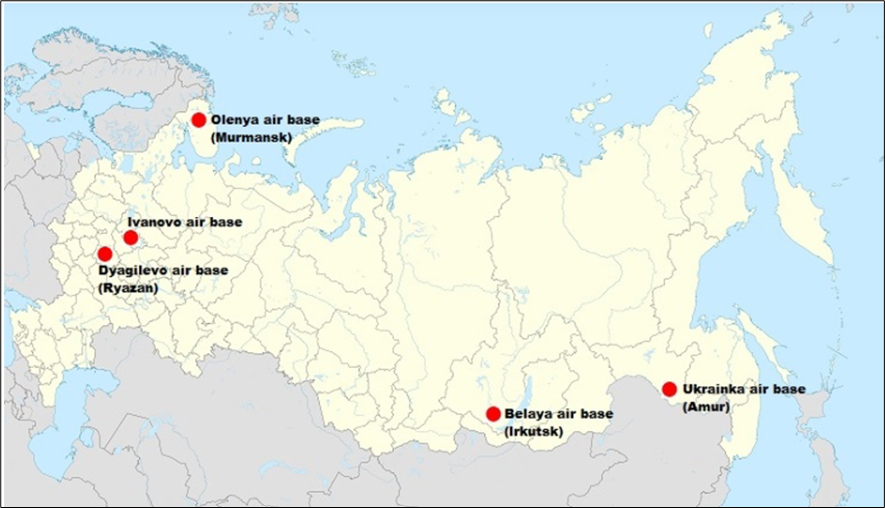
Damage assessment. Ukrainian and Western sources claimed that 41 bombers were hit and 34% of the Russian bomber force was destroyed. Very soon, a number of prominent military analysts realized that these figures are completely overstated. Firstly, only two of the five attacks were successful. The attacks on the other three locations were either averted by drone defense or because the drone launches malfunctioned. Based on the analysts, five strategic bombers were damaged and two destroyed totaling 7 aircraft (TU-95M and TU.22M). This means only 3% of total 160 bomber aircraft in active use.
The size range of damage to the Russian strategic bomber fleet will not affect Russia’s ability to deploy them, as their overall losses are about three percent of their total force. The term “Pearl Harbor” used by Western and Ukrainian propaganda media is a misleading analog to describe this attack. This was not a military attack by the Ukrainian forces but a long-planned tactical operation by Ukraine’s Security Service (SBU).
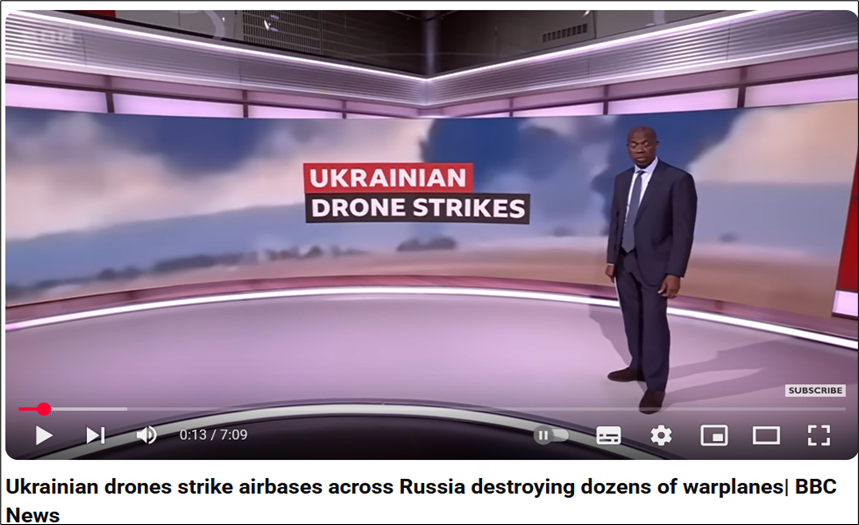
Ukrainian drones strike airbases across Russia destroying dozens of warplanes| BBC News
BBC News , June 2, 2025
Ukraine has carried out an audacious attack on Russia’s airforce, using drones to destroy as many as 40 warplanes at military bases across the country. President Volodymyr Zelensky said 117 drones were used in the so-called “Spider’s Web” operation by the SBU security service. They were smuggled into Russia hidden in wooden mobile cabins, moved close to the airbases, then launched by remote control. Ukrainian sources told it had taken 18 months to plan and carry out the operation.
CIA, MI-6 Involvement. It’s clear that the Ukrainians couldn’t have carried out this attack without Western support. The Ukrainian Security Service (SBU) has revealed details of an operation codenamed “Spider Web.” First, FPV drones were smuggled across the border. Then, mobile wooden houses were placed on trucks, each housing a drone. At the right moment, the roofs of the containers were opened by remote control, and the drones flew off to attack Russian bombers.
This description seems to be likely and correct. However, the Ukrainians needed information about targets thousands of kilometers away from Ukraine, which can only come from the US satellites. Communication with the drones also does not appear to be possible via the normal mobile phone network, which makes the involvement of NATO forces likely.

Larry C. Johnson: Ukraine Is Committing TOTAL SUICIDE
Dialogue Works, interviewed by Nima R. Alkhorshid, June 2, 2025
Col. Larry Wilkerson: Trump’s Grip on Ukraine Conflict Is SLIPPING — What Happens Next?
Dialogue Works, interviewed by Nima R. Alkhorshid, June 2, 2025
While Western headlines celebrated Operation Spider’s Web as a daring feat of Ukrainian ingenuity, a closer look reveals something far more calculated – and far less Ukrainian. This wasn’t just a strike on Russian airfields. It was a test – one that blended high-tech sabotage, covert infiltration and satellite-guided timing with the kind of precision that only the world’s most advanced intelligence networks can deliver. The question,” Who was really pulling the strings?”, gets the quick reply: NATO, CIA, MI-6 and possibly German and French intelligence agencies.

Zelensky’s drone operations “were supported by the CIA and MI6.” – Jeffrey Sachs.
Interesting new features have emerged some days later regarding the Ukrainian strike:
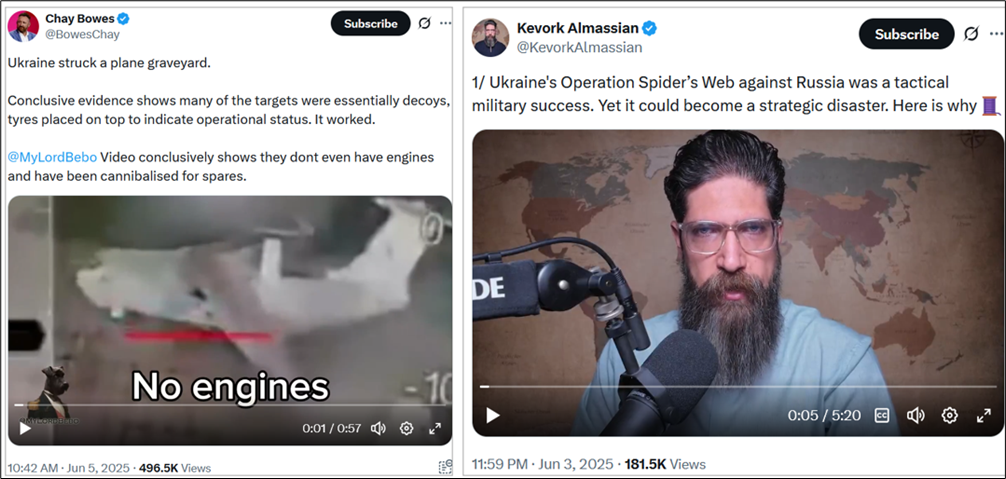
Analysis by Kevork Almassian, June 3, 2025
Message by Chay Bowes, June 5, 2025
The New START Treaty & US-Russia relations, Red Lines Crossed
This operation was a betrayal of the American people, managed by Zelesky’s regime. Thus, operation “Spiderweb” not only jeopardizes strategic stability, but also brings closer the moment when any mistake could lead to a global crisis. Therefore, the very limited tactical success of the attack comes at a huge price not only for the US. They crossed a line, which Russia drew in the sand with blood-red paint. All this, for a propaganda victory that will last a few days?
The US and others Western agencies played a significant role in the Ukrainian attack, a fact that the Western media has failed to mention. Russia’s strategic bombers, such as Tu-95 and Tu-160, have been stationed in open areas as required by The new START Treaty (Treaty on Measures for the Further Reduction and Limitation of Strategic Offensive Arms) between the United States and the Russian Federation. This treaty, signed in 2010, obliged the parties to ensure transparency regarding nuclear weapons, including the possibility of satellite monitoring and inspections.
As of June 2025, the New START Treaty is still legally binding for the United States, even though Russia has in 2023 suspended (not ended!) its participation. The treaty itself remains in force until February 4, 2026, following its 5-year extension in 2021. The US has not withdrawn from the treaty or suspended its obligations. Therefore, the US remains bound by the treaty’s limits and continues to report its compliance (although verification mechanisms have broken down since Russia’s suspension).
Attempts to undermine Russia’s nuclear capability are not limited to the current attacks on strategic bombers. Other incidents aimed at weakening the nuclear deterrence have been recorded earlier: attacks on the early warning system in 2023-2024, Ukrainian forces attempted to strike missile early warning system radar stations (e.g. Voronezh-DM radar at Armavir and the Voronezh-M radar near Orsk) These radars are integral components of Russia’s strategic nuclear deterrent, designed to detect incoming ballistic missile threats.
In late 2024, Russia revised its nuclear doctrine. The updates followed reports that US President Joe Biden had authorized Kyiv to use long-range missiles to strike targets inside Russia, a move the Kremlin warned could lead to a significant new round of escalation. But of course, this was also an answer to the forementioned attacks. The updated doctrine, approved by President Vladimir Putin in November 2024, expands the conditions under which Russia might consider using nuclear weapons.
Key changes include:
- Treating aggression from a non-nuclear state, supported by a nuclear power, as a “joint attack” warranting potential nuclear retaliation.
- Considering large-scale conventional attacks using missiles, drones, or aircraft as possible triggers for a nuclear response.
- Lowering the threshold for nuclear use from situations threatening the “very existence of the state” to those posing a “critical threat to sovereignty or territorial integrity.”
President Vladimir Putin has repeatedly emphasized that attacks on critical facilities, including nuclear infrastructure, are a direct challenge to Russia’s security and require a tough response. In case of further provocations, Moscow may consider “asymmetric measures”, including strikes on NATO decision-making centers.
Russia says that President Putin is preparing to retaliate at “a time of our choosing” for all the latest drone and ‘terror attacks’ – including the targeting of trains and bridges with explosives. “Russia will respond to Ukraine’s latest attacks as and when its military sees fit,” the Kremlin said Thursday. Spokesman Dmitry Peskov confirmed what President Trump revealed of the Putin phone call Wednesday – that the Russian leader made clear that Moscow is obliged to retaliate.
Peskov, speaking of Putin’s first televised address since the devastating Sunday drone attacks deep inside Russian territory said, “The president described the Kyiv regime as a terrorist regime, because it was the regime’s leadership that consciously gave the order, the command, the order to blow up a passenger train.” “This is nothing other than terrorism at the state level. This is an important statement by the president,” he added.
US President Donald Trump was not notified by Kiev about its plans to attack Russian airfields, White House Press Secretary Karoline Leavitt said. “He was not,” she told reporters answering a corresponding question. When asked about the US administration’s position on Kiev’s attacks on Russian airfields, she said that she would prefer the president to express it.
For decades, nuclear treaties held the world back from the edge—bombers had to stay visible, silos locked, no one could strike first without warning. That fragile balance is what kept World War III from happening.
Zelensky just blew it all up. He tore up the rulebook, destroyed decades of stability, and hurled the world straight into Cold War-style chaos. Anyone who helped make this happen isn’t just reckless—they’re a threat to humanity. And those celebrating? Completely deranged.
Strike on Russian base is a stark warning for US forces on Guam. China could readily replicate Ukraine’s surprise drone blitz to target America’s disjointed defenses and exposed aircraft on Guam. Ukraine’s deep strike on Russia’s bomber bases sends a warning that the US risks a similar blow in Guam, where exposed airfields and fragmented defenses leave it open to a Chinese first strike.
If China were to consider a Pearl Harbor-like pre-emptive strike to neutralize US airpower on the ground to forestall intervention in a Taiwan conflict, it would most likely be through a multi-vector attack involving ballistic missiles, cruise missiles and drones launched from the Chinese mainland, dual-use infrastructure, warships and submarines, civilian vessels and embedded special forces teams.
Russian revenge strikes, escalation
Russia’s response to Ukraine’s spate of terrorist attacks over the weekend is best captured by the phrase, “Revenge is a dish best served cold.” This means that revenge is often more satisfying or effective when it is delayed, carefully planned, and not acted on in the heat of emotion.
Russia’s military doctrine vis-a-vis Ukraine has been, until now, described as a Special Military Operation. In response to the drone attacks on Russia’s strategic bomber bases, Putin has now characterized the military mission as a Counterterrorism Operation. When the Russian government states that it is treating Ukraine as a “counterterrorism operation,” it signifies a strategic shift in rhetoric, tactics and the legal framework, allowing for expanded military and domestic security measures. By framing its military actions as counterterrorism, Russia aims to escalate its use of military force: This means intensified military operations against Ukraine going forward.
Ukraine’s attacks over the weekend have strengthened public support for destroying, via military means, the “terrorist” threat posed by Ukraine. Putin made that point clearly and strongly to Donald Trump during their conversation on Wednesday. While Russia is not likely to strike outside the territorial boundaries of Ukraine, it will hit sites linked to foreign interests, which is likely to include British targets, still operating in Ukraine.

Massive Russian Strike Hits Lutsk Bunker Holding NATO Missiles: Storm Shadow, Patriot, ATACMS | APT
APT , June 7, 2025
In a major escalation of Russia’s long-range strike campaign, a high-value underground bunker near Lutsk, Ukraine, has reportedly been destroyed. According to military sources and satellite imagery, the facility housed 56 British-supplied Storm Shadow missiles, 32 U.S.-made Patriot air defense missiles, and 53 American ATACMS tactical ballistic missiles. Russian sources claimed responsibility for the strike, calling it a “crippling blow” to Kyiv’s deep-strike and air defense capabilities. Ukrainian officials have yet to confirm the loss, but if verified, it would mark one of the largest single-day missile stockpile destructions of the war.
215 Missiles & Drones Crush Kharkiv, 3 Dead, 22 Wounded in Russia’s Russia’s Ruthless Rage| TN World
Times Now World, June 7, 2025
Russia has launched a sweeping retaliatory strike on Kharkiv, Ukraine’s second-largest city, killing at least three and injuring 22—including an infant—in response to a Ukrainian drone attack on Russian military airfields. In what Mayor Ihor Terekhov called the most powerful assault since the 2022 invasion, more than 215 drones, missiles, and bombs hit homes, schools, and infrastructure. While Ukraine’s defenses intercepted dozens of drones, they were overwhelmed by the scale. With Moscow rejecting peace overtures, the path to a cease-fire looks increasingly bleak.
THE First Russian Strike last night An underground bunker
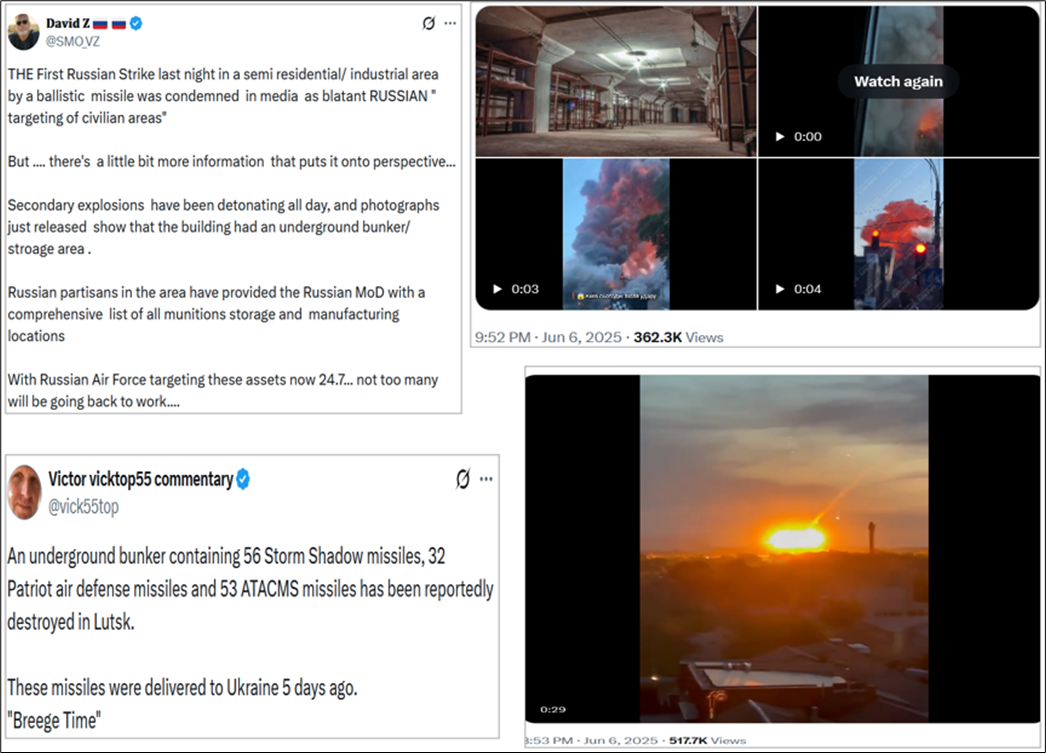
DRONE WARFARE ESCALATES — RUSSIA ADVANCES ON ALL FRONTS. Reports confirm deadly drone strikes are increasing along the line of contact. Russian forces are laying waste to Ukrainian positions, moving at unprecedented speed. Drone warfare has reached a new level of lethality and precision. The front is collapsing — and NATO can’t stop the tide. Zelensky is no longer a viable leader, he’s a liability. It’s time to remove Zelensky and hold immediate elections.
launch of Kinzhal Hypersonic MissileStrikes by the Russian MoD on Kharkov.

The Russians hit locations with British and French troops June 4, 2025. Russian forces carried out a precise strike in the Odesa region and according to claims from the field, units with French instructors were among the hit, says Sergey Lebedev, coordinator of the resistance movement from Mykolaiv. Just a day before, on the night between June 2 and 3, the city was also under attack. At that time, as stated, aircraft known as “Gerans” were used in the attacks, and a warehouse with advanced unmanned platforms was hit. What further increases the tension is the fact that there is more and more talk about the presence of foreign elements in the structure of Ukrainian operations – the presence of French mercenaries.
The media continues to analyze the retaliatory strike of June 2 on targets in Ukraine. Russia launched about 400 drones, Iskanders and FAB bombs with a universal planning and correction module. Very symbolically, five strategic bombers also participated in the missile strike — as if avenging their “wounded brothers”. The results are stunning: In Poltava, Iskanders crushed the command post of the airport, killing quite a few NATO soldiers; In Odessa, a warehouse overflowing with weapons and ammunition was destroyed; Kiev suffered the most hits, where a powerful detonation of ammunition occurred; During the formation, cluster Iskanders were launched at training grounds in the Kharkiv, Sumy and Dnipropetrovsk regions; at the air base of the Armed Forces of Ukraine “Ozyorna” in the Zhytomyr region, F-16 and MiG-29 aircraft were allegedly on fire.
Trump – Putin contacts
On June 4, the presidents of Russia and the US held their fourth phone call since Trump had taken office. The heads of state discussed the situation in Ukraine, with Puin detailing the outcome of the Istanbul talks with Ukraine and assessing the Kiev regime’s terrorist attacks. Putin said he will have to respond to Ukraine’s major drone attack on Russian airbases, Donald Trump has warned.
The fourth phone conversation lasted an hour and ten minutes. In their previous call, Putin and Trump discussed bilateral relations and ways to resolve the Ukraine conflict, including the idea of memorandums between Moscow and Kiev, which would set out the views of the parties on a potential truce. Prior to that, the presidents of Russia and the United States spoke on February 12 and March 18. They addressed efforts to normalize relations between Moscow and Washingtonand various aspects of settling the conflict in Ukraine.
Wednesday’s phone call between Putin and Trump predictably caused an uproar in the Western deep state and the media outlets it controls, Kirill Dmitriev, CEO of the Russian Direct Investment Fund (RDIF), said. He pointed out that the West and the media under its control saw any prospect for dialogue and cooperation as a direct threat to the system built on what he called “managed instability.”
After two days of deafening silence from the White House on Ukraine’s Sunday massive drone assault, dubbed ‘Operation Spider’s Web’, President Trump has finally reacted publicly.
The president revealed he has held a phone call with President Vladimir Putin on Wednesday, which significantly lasted about an hour and fifteen minutes. Trump warned that peace is not very close on the horizon and that the two leaders covered several pressing issues in their conversation. “We discussed the attack on Russia’s docked airplanes, by Ukraine, and also various other attacks that have been taking place by both sides.” Trump went on to call it a good conversation, however “not a conversation that will lead to immediate Peace.” That’s when Trump clarified that “President Putin did say, and very strongly, that he will have to respond to the recent attack on the airfields.” Trump warned in a social media post that the phone call, would not “lead to immediate peace” between Russia and Ukraine. Trump told Putin during the call that the US was not warned in advance of the attack.
On Friday Trump was asked whether Ukraine’s drone strikes deep inside Russia changed his view of Zelensky’s “cards”. For months, Trump has said that Kiev has no cards to play, but reporters wondered if last Sunday’s ‘Operation Spider’s Web’ has changed where things stand in Trump’s mind. Trump responded to reporters aboard Air Force One by saying, “Well they gave Putin a reason to go in and bomb the hell out of them last night. That’s the thing I didn’t like about it.”

Following two Ukrainian terrorist attacks on bridges in Kursk and Bryansk and Sunday’s drone attack on five Russian airfields that host Russian strategic bombers, Russian Foreign Minister Sergey Lavrov called US Secretary of State Marco Rubio late on June 1, 2025. Lavrov wanted to discuss the ongoing conflict in Ukraine and the forthcoming peace talks scheduled for June 2 in Istanbul. During the discussion, both officials reportedly examined various initiatives aimed at resolving the crisis and emphasized the importance of direct negotiations between Russia and Ukraine. Secretary Rubio reaffirmed Trump’s commitment to supporting talks that lead to lasting peace and expressed condolences for the casualties resulting from recent attacks in Russian regions bordering Ukraine.
Lavrov, at the direction of Vladimir Putin, called Rubio to deliver a stern message and a warning to President Trump. Lavrov conveyed Putin’s deep concern that the US played a role in facilitating these attacks and that the Russian government was prepared to take strong action because the attack on the airfields represented a direct threat to Russia’s nuclear capabilities. Lavrov was sending a simple, stark message: Russia is going to punish Ukraine and any countries that provided assistance, whether materiel or intelligence, to this act of war.
The next day, June 2nd, Russia’s lead negotiator, Vladimir Medinsky, met with Ukraine’s Defense Minister, Rustem Umerov, in advance of the formal meeting between the delegations of the two countries. Medinsky delivered an ultimatum to Umerov, i.e., this is your last chance to accept this deal or face worse consequences. Russian Presidential Aide Yury Ushakov told a briefing after the call that the leaders had also touched upon a number of other issues.
NATO’s latest meetings, June 3-4
Defense Secretary Pete Hegseth was not attending a Wednesday meeting of 50 defense ministers at NATO headquarters in Brussels that has been critical to coordinating military aid for Ukraine, marking the first time in three years a Pentagon chief has skipped the event. The regular meetings of NATO defense ministers and others have coordinated funding for the Ukraine war, and have emerged as a key component for Western aid for Kyiv as it has battled Russian forces. But the Trump administration has distanced itself from the group, handing over leadership to the UK and Germany.
Hegseth’s absence appears to signal further softening of the Trump administration’s relationship with Europe, and Ukraine. The Defense secretary will be in Brussels for Thursday’s meeting of NATO defense ministers but his place at Wednesday’s Ukraine Defense Contact Group will be taken by US ambassador to NATO Matthew Whitaker.
The UK and Germany took over leadership of the group in February after Hegseth said the US would no longer play a role in the monthly meetings established by then-Defense Secretary Lloyd Austin in April 2022. Since that February meeting, UK Defense Minister John Healey, and Germany’s defense chief, Boris Pistorius, have run the show, with Hegseth only attending virtually last month. The pair will chair Wednesday’s meeting as well.
THE BEST ACHIEVEMENT OF NATO IS THE CEMETERY EXPANSION IN UKRAINE

Some expert assessments on the recent situation regarding the NATO and Ukraine
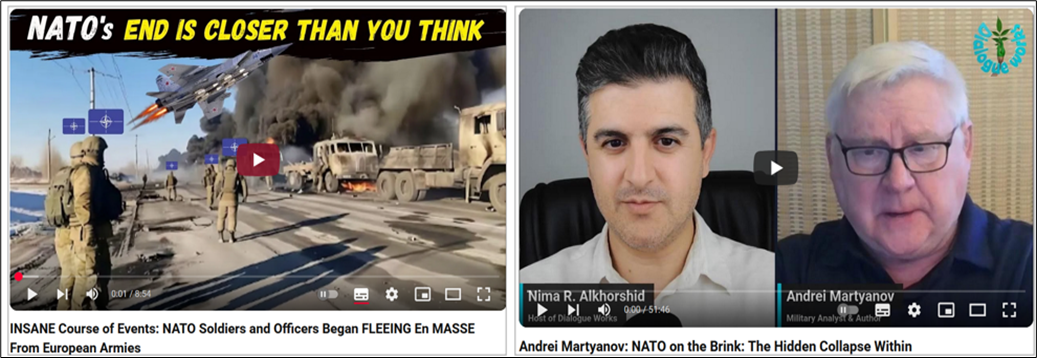
INSANE Course of Events: NATO Soldiers and Officers Began FLEEING En MASSE From European Armies
BORZZIKMAN , April 2, 2025
Andrei Martyanov: NATO on the Brink: The Hidden Collapse Within
Dialogue Works , interviewed by Nima R. Alkhorshid, April 16, 2025

Col. Douglas Macgregor: “NATO Will Not Survive This War” (Clip 9 May 2025)
Glenn Diesen , interviewed by prof. Glenn Diesen, May 18, 2025
NATO’s Collapse? | Douglas Macgregor Interview
Counter Currents , May 20, 2025
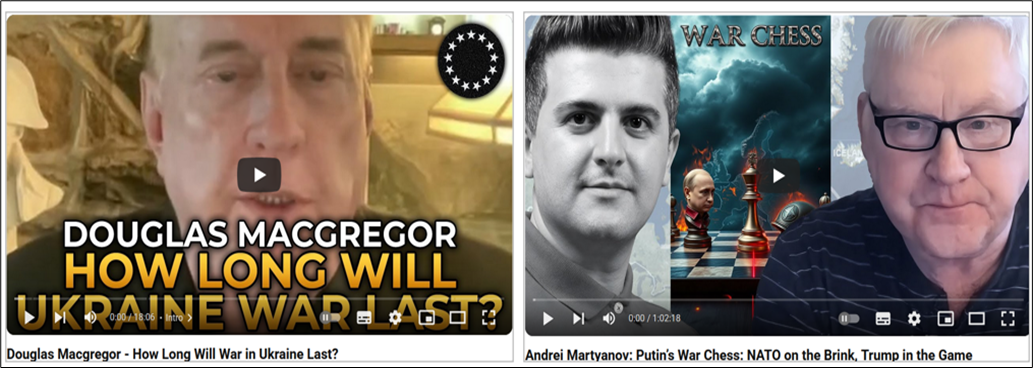
Douglas Macgregor – How Long Will War in Ukraine Last?
Liberty Vault, May 21, 2025
Andrei Martyanov: Putin’s War Chess: NATO on the Brink, Trump in the Game
Dialogue Works , interviewed by Nima R. Alkhorshid, May 21, 2025

Douglas Macgregor: SURRENDERED!!!
fresh info insight , May 22, 2025
Moscow Warns Talks Kiev’s Last Chance Total Defeat If Talks Fail; Rubio Warns Against More Sanctions
Alexander Mercouris , May 21, 2025

Douglas Macgregor: ELIMINATED!!!
fresh info insight , June 6, 2025
Switzerland’s Most Feared Academic EXPOSES Nato War Lies | Dr. Daniele Ganser
Neutrality Studies , interviewed by Pascal Lottaz, June 7, 2025
When looking this setup (NATO – Ukraine) in the wider framework, new features will emerge

“No One Is Prepared for What’s Coming… | Jeffrey Sachs WARNING”
Unfiltered Minds , June 4, 2025
In this powerful interview, renowned economist and geopolitical analyst Jeffrey Sachs delivers a sobering warning: the world is edging dangerously close to nuclear war—and no one seems prepared. Sachs breaks down the recent Ukrainian strike on Russia’s strategic nuclear forces and explains why this marks a terrifying escalation. He questions whether the U.S. government is complicit or simply out of control, calling either scenario a disaster in the making. Sachs pulls no punches as he critiques Western leadership, intelligence agencies, and the media for fueling the conflict rather than seeking peace. He highlights the recklessness of continued NATO expansion and the refusal to address Russia’s core security concerns.
“Most People Have No Idea What is Happening | Richard Wolff”
Unfiltered Minds , June 7, 2025
In this powerful talk, economist Richard Wolff breaks down the unraveling of U.S. global dominance and the rise of a new economic order led by China, Russia, and the BRICS alliance. He explains how decades of overreach, failed sanctions, and economic missteps have pushed the United States into a state of desperation—taking chaotic, high-risk actions that are backfiring on the world stage. Wolff explores why traditional tactics like embargoes, tariffs, and threats no longer work, and how much of the world is now resisting U.S. influence. This is a sobering look at what happens when an empire in decline refuses to adapt, and why most people still don’t realize the scale of what’s happening.

John Mearsheimer: New World Order? US, China & Russia in the New Great Power Rivalry
Glenn Diesen , May 28, 2025
John J. Mearsheimer is the R. Wendell Harrison Distinguished Service Professor of Political Science at the University of Chicago, where he has taught since 1982. Prof. Mearsheimer discusses how the shift from American hegemony to multipolarity compels the great powers to develop very different strategies. Liberal delusions are fading away and states must see the world as it is, not how they would like it to be.


